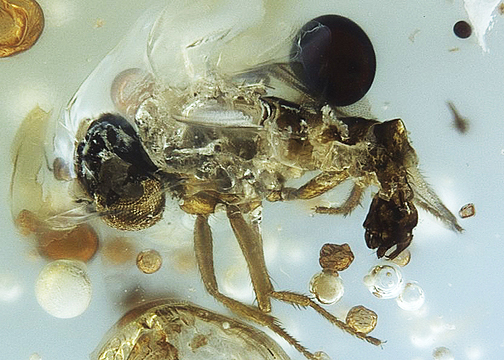Abstract
The family Dolichopodidae (Diptera) from the Eocene amber of the Cambay and Kutch, India is reviewed. Based on a sample of 38 inclusions, the fauna preserved in amber reveals that the family was well-differentiated by early the Eocene. Palaeomedeterus cambayensis Bickel sp. nov. is described and provisionally assigned to the Peloropeodinae, and is congeneric with European Baltic amber species, suggesting the genus was widespread for a considerable time period in both Europe and India. Two small-sized new monotypic genera are also described, Gujaratmyia rotunda Bickel gen. et sp. nov. and Rajpardia grimaldii Bickel gen. et sp. nov. Also included are undescribed members of the dolichopodid subfamilies Diaphorinae and Medeterinae, and unplaced species. The Baltic amber species Prohercostomus noxialis (Meunier, 1907) is regarded as the new senior synonym of Sympycnites primaevus Grimaldi & Cumming, 1999, described with a mistaken provenance of Cretaceous Lebanese amber.
References
- Agnihotri, P. & Singh, H. (2020). Eocene biodiversity of Eocene amber from the Umarsar Lignites, Kutch Basin, Gujarat- India. Journal of the Palaeontological Society of India, 65 (2), 214–218.
- Bickel, D.J. (2009) 49. Dolichopodidae (long-legged flies). In: Brown, B.V., Borkent, A., Cumming, J.M., Wood, D.M., Woodley, N.E. & Zumbado, M.A. (Eds), Manual of Central American Diptera. Volume 1. NRC Research Press, Ottawa, pp. 671–694.
- Cumming, J. M. & Wood, D. M. (2017) Adult morphology and terminology. In: Kirk-Spriggs, A.H. & Sinclair, B. J. (Eds), Manual of Afrotropical Diptera. Volume 1. Suricata 4. South African National Biodiversity Institute, Pretoria, p. 89–133.
- Cumming, J.M. & Brooks, S.E. (2019) Phylogenetic analysis and preliminary classification of the Parathalassiinae (Diptera: Empidoidea: Dolichopodidae sensu lato). Zootaxa, 4648 (1), 111–129. https://doi.org/10.11646/zootaxa.4648.1.5
- Evenhuis, N.L. (2014) Family Dolichopodidae. In: Evenhuis, N. L. (Ed.), Catalogue of the fossil flies of the world (Insecta: Diptera) website. Version 2.0. Available at: http://hbs.bishopmuseum.org/fossilcat/fossdolicho.html. (Accessed 13 September 2022).
- Evenhuis, N.L. & Pape, T. (Eds) (2022) Systema Dipterorum. Version 3.9. Available at: http://diptera.org/nomenclator/ (Accessed 13 September 2022).
- Grichanov, I.Ya (1997) Prohercostomus, a new subgenus of the genus Hercostomus Loew (Diptera, Dolichopodidae) from Baltic amber. Paleontologicheskii Zhurnal, 5, 82–85. [In Russian; English translation, Paleontological Journal, 31 (5), 520–522.]
- Grichanov, I.Ya. & Brooks, S.E. (2017) Dolichopodidae (Long-legged Dance Flies), In: Kirk-Spriggs, A.H. & Sinclair, B. J. (Eds), Manual of Afrotropical Diptera. Volume 2. Suricata 5. South African National Biodiversity Institute, Pretoria, pp. 1265–1320.
- Grichanov, I.Ya. & Negrobov, O.P. (2018) Peloropeodinae (Diptera: Dolichopodidae) from Baltic amber. Caucasian Entomological Bulletin, 14 (1), 95–104. https://doi.org/10.23885/1814-3326-2018-14-1-95-104
- Grimaldi, D.A. & Cumming, J. (1999) Brachyceran Diptera in Cretaceous ambers and Mesozoic diversification of the Eremoneura. Bulletin of the American Museum of Natural History, 239, 1–124.
- Khanolkar, S. & Sharma, J. (2019) Record of Early to Middle Eocene paleoenvironmental changes from lignite mines, western India. Journal of Micropalaeontology, 38 (1), 1–24. https://doi.org/10.5194/jm-38-1-2019
- Lim, G.S., Hwang, W.S., Kutty, S.N., Meier, R. & Grootaert, P. (2010) Mitochondrial and nuclear markers support the monophyly of Dolichopodidae and suggest a rapid origin of the subfamilies (Diptera: Empidoidea). Systematic Entomology, 35, 59–70. https://doi.org/10.1111/j.1365-3113.2009.00481.x
- Meunier, F. (1895) Les Dolichopodidae de l’ambre tertiaire. Annales de la Société Scientifique de Bruxelles (Mémoires), 19, 173–175.
- Meunier, F. (1899) Révision des diptères fossiles types de Loew conservés au Musée Provincial de Koenigsberg [part]. Miscellanea Entomologica, 7, 169–182.
- Meunier, F. (1907a) Monographie des Dolichopodidae de l’ambre de la Baltique [part]. Le Naturaliste, (2) 29, 197–199.
- Meunier, F. (1907b) Monographie des Dolichopodidae de l’ambre de la Baltique [part]. Le Naturaliste, (2) 29, 209–211.
- Meunier, F. (1907c) Monographie des Dolichopodidae de l’ambre de la Baltique [part]. Le Naturaliste, (2) 29, 221–222.
- Nascimbene, P. & Silverstein, H. (2001) The preparation of fragile Cretaceous ambers for conservation and study of its organismal inclusions. In: Grimaldi, D. (Ed.), Studies on fossils in amber, with particular reference to the Cretaceous of New Jersey. Backhuys Publishers, Leiden, The Netherlands, p. 93–102.
- Robinson, H. (1970) The subfamilies of the family Dolichopodidae in North and South America (Diptera). Papéis Avulsos de Zoology, Sâo Paulo, 23 (6), 53–62.
- Rust, J., Singh, H., Ran, R.S., McCann, T., Singh, L., Anderson, K., Sarkar, N., Nascimbene, P.C., Stebner, F., Thomas, J.C., Solórzano Kraemer, M., Williams, C. J., Engel, M.S., Sahni, A. & Grimaldi, D. (2010) Biogeographic and evolutionary implications of a diverse paleobiota in amber from the Early Eocene of India. Proceedings of the National Academy of Sciences, 107 (43), 18360–18365. https://doi.org/10.1073/pnas.1007407107
- Sahni, A. (2006) Biotic response to the India-Asia collision: changing palaeoenvironments and vertebrate faunal relationships. Palaeontographica, Abteilung A, 15–26. https://doi.org/10.1127/pala/278/2006/15
- Saraswati, P. K., Khanolkar, S. & Banerjee, S. (2018) Paleogene stratigraphy of Kutch, India: an update about progress in foraminiferal biostratigraphy. Geodinamica Acta, 30 (1), 100–118. https://doi.org/10.1080/09853111.2017.1408263
- Shamshev, I. V. & Perkovsky, E. E. (2022) A review of fossil taxa of Microphorinae (Diptera, Dolichopodidae sensu lato), with redescription of the Eocene genus Meghyperiella Meunier. Zootaxa, 5150 (3), 411–427. https://doi.org/10.11646/zootaxa.5150.3.6
- Sinclair, B.J. & Cumming, J.M. (2006) The morphology, higher-level phylogeny and classification of the Empidoidea (Diptera). Zootaxa, 1180 (1), 1–172. https://doi.org/10.11646/zootaxa.1180.1.1
- Singh, H. (2020) Palaeoenvironmental and taphonomic biases in palynological assemblages preserved in amber versus sediments from the Umarsar Lignite, Kutch Basin, Gujarat, India. Historical Biology, 33 (10), 2305–2315. https://doi.org/10.1080/08912963.2020.1791105
- Stebner, F., Szadziewski, R., Singh, H., Gunkel, S. & Rust, J. (2017a) Biting midges (Diptera: Ceratopogonidae) from Cambay amber indicate that the Eocene fauna of the Indian subcontinent was not isolated. PLoS ONE, 12 (1), 1–24. e0169144. https://doi.org/10.1371/journal.pone.0169144
- Stebner, F., Baranov, V., Zakrzewska, M., Singh, H. & Gilka, W. (2017b) The Chironomidae diversity based on records from early Eocene Cambay amber, India, with implications on habitats of fossil Diptera. Palaeogeography, Palaeoclimatology, Palaeoecology, 475, 154–161. https://doi.org/10.1016/j.palaeo.2017.03.019
- Zakrzewska, M., Singh, H., Wagner-Wysiecka, E. & Giłka, W. (2020) Minute and diverse in fossil sticky stuff: Tanytarsini (Diptera: Chironomidae) from early Eocene Indian Cambay amber. Zoological Journal of the Linnean Society, 139 (4), 1398–1425. https://doi.org/10.1093/zoolinnean/zlz159


